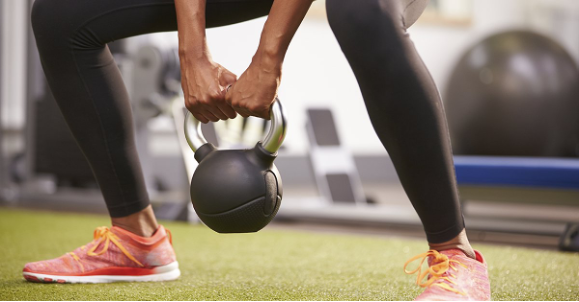Kettlebell training
- Oct 4, 2022
- 4 min read
Updated: Jan 20, 2023
WHAT IS A KETTLEBELL?

A kettlebell is a spherical, cast-iron weight with a handle ranging from 4kg to 40 kg They were used by strongmen in Russia for strength training and competitions. They’ve since gained popularity with fitness buffs and gyms around the world and come in a wide variety of colours and weights. The idea is to hold the kettlebell in one or both hands and go through a variety of exercises like the two arm swings, variations of squats, loaded carry, Turkish get ups etc. Some movements have you changing the weight from hand to hand as the weight swings up or as you move laterally, requiring you to stabilize the body and engage the core in a whole new way. Other moves require power from the legs and hips to move the weight, giving you integrated whole-body movements that are often missing with other types of training.
HISTORY OF KETTLEBELL
Kettlebells have their origin in ancient Russia where importance was placed on physical strength. In 1704 was first recorded in Russian dictionary word girya meaning a traditional Russian weight. Russian farm workers first used swings and press with the girya in order to demonstrate strength. In 1948 kettlebell lifting became the national sport of the Soviet Union. Athletes competed in the double kettlebell jerk and the single-arm snatch. The winner was the athlete who lifted the most repetitions, irrespective of time or technique . By 1960s kettlebell had been introduced in schools and universities. in 1981 USSR government created official kettlebell commission and mandated kettlebell training for all workers as an way to improve fitness and productivity of the working class. In 1985. kettlebell sport (girevoy sport) was officially a formal sport with rules and regulations. That year the first USSR national kettlebell championship was held in Lipetsk, Russia. In 1993. the first world championship was held for men and in 1999. women competed for the first time. Today kettlebells are used all over the world. The number of people using kettlebells in homes, gyms and sport clubs are increasing every day.
BENEFITS OF KETTLEBELL TRAINING
Almost any exerciser can benefit from kettlebell training. The American Council on Exercise commissioned a study to find out just how effective kettlebell training is. After eight weeks of kettlebell exercises, researchers saw significant improvement in endurance, balance, and core strength. The greatest improvement was in the core where strength increased a whopping 70 percent.
The benefits include:
Improved coordination and agility.
Better posture and alignment – Many exercises work the postural muscles in a functional way.
Time efficient – You train multiple fitness components in the same session including cardio, strength, balance, stability, power, and endurance
The exercises are functional and weight bearing which helps increase bone density and keep the body strong for daily tasks.
You become more efficient at other types of exercise.
Increased power development and endurance
It can help protect athletes from injuries – Many injuries happen when you’re moving fast and have to come to a stop (a.k.a., eccentric deceleration). Kettlebell exercises actually train the body in eccentric deceleration, which can translate to a healthier, stronger body on the court or field.
Improved back pain – One interesting study published in The Journal of Strength and Conditioning Research found that kettlebell training offered some unique loading patterns we don’t see with traditional strength training. Because the lower back is activated during swings, this actually enhances the functioning and health of the lower back.
Simplicity – the exercises are simple, the workouts are straight forward and you only need one piece of equipment, although you may need a variety of weights.
KETTLEBELLS VS DUMBBELLS
The main difference between kettlebell and dumbbell is the way it’s shaped. The u-shaped handle and rounded shape changes how the weight works with your body.
Because the centre of gravity lies outside of your hand in the kettlebell, it can change depending on how you’re holding it and moving it. The momentum of kettlebell movements creates centrifugal force , focusing more attention on the muscles used for deceleration and stabilization. Kettlebell multi-directional movements mimic real life movements such as swinging, farmers walks, Turkish get ups etc. Dumbbells are good for building muscle and strength with slow, controlled movements while kettlebell training involves the entire body and focuses on endurance, power and dynamic movements.
KETTLEBELL TRAINING EXERCISES
Power: One and two hand swings, one hand alternate swings, cleans (from bottom, hang and swing positions), one hand and two snatches (from bottom, hand and swing positions), one and two hand clean and press, sumo squat jump, suitcase hold squat jump, lunge jumps (goblet and suitcase hold).
Upper body pulling: Upright rows, bent over row, renegade rows.
Upper body pushing: One and two hand overhead presses, one and two hand horizontal press, one and two hand push-ups.
Knee dominant: Squats (goblet, overhead, sumo, suitcase, front, single hand, two hands etc), split squats (rear foot elevated, goblet, suitcase, overhead, front etc), lunges (forward, reverse, side), single leg squats.
Hip dominant: Romanian deadlifts, good mornings, single leg deadlifts.
Full body: Farmer’s walks (suitcase, front, overhead, single hand, two hand), Turkish get ups (quarter, half, full etc), windmill get ups, combat grappler get ups, plank row, plank pull through, windmills, bent press, side press, figure eight etc.
Mobility: Halo, side lunge








Comments